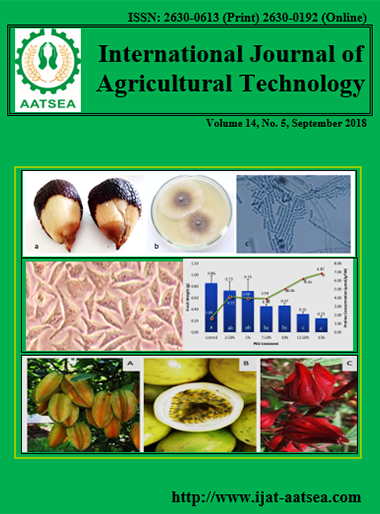Effect of Protein Content in Feed Formulas on Growth and Nutritional Values of Mealworms
Main Article Content
Abstract
An experiment was designed to determine the effects of high dietary protein feeding on the growth and nutritional values of mealworms. The experiment was designed as completely randomized design with 5 treatments consisting of 5 feeding formulas mixed on weight basis: I) wheat bran II) broiler chicken feed + soybean meal (3:1) III) broiler chicken feed+ soybean meal (1:3) IV) broiler chicken feed+ soybean meal (1:1) and V) broiler chicken feed + soybean meal (1:1) and 10 replications. Mealworms (850 insects) aged 2 weeks were raised in a plastic box at room temperature (35-38 oC) with carrot as water supplement for 8 weeks. Average weight gain, length measurement and percentage mortality were calculated every week over feeding periods. On the eighth week, the results showed that the mealworms raised with the formula I and III had maximum weight of 0.15 g. Their body length of mealworms from formula I were the longest (2.70 cm) and no statistically different was found in mortality rate among treatments (p>0.05). The results indicated that high protein feed did not have effect on weight and body length of mealworms. The cost of 5 feeding formulas in rearing 850 mealworms for 8 weeks was as follows :2.52, 3.91, 4.13, 4.02 and 4.00 $, respectively. The studies indicated that the mealworms fed with formula I had gained maximum growth with minimum cost of production.
An analysis of the chemical composition of the raw materials in feed formulas for mealworms indicated that soybean meal had highest protein content, following by soybean, broiler chicken feed, rice bran and carrot 48.82, 39.35, 21.18, 18.72 and 7.06%, respectively. Soybean had highest amount of fat, 20.14%. It was found that mealworms fed with formula IV had the highest protein of 54.89%. The mealworms raised from the formula I and II had the highest fat 29.54 and 29.88, respectively and highest energy found in mealworms from formua I, 6,193.22 cal/g.
Article Details

This work is licensed under a Creative Commons Attribution-NonCommercial-NoDerivatives 4.0 International License.
References
Aaron T. and Dossey, I. (2013). Why Insects Should Be in Your Diet. The Scientistist Magazine February 1, 2013.
Ademolu, K. O., Idowu, A. B. and Olatunde, G. O. (2010). Nutritional value assessment of variegated of Zasshopper, Zonocerus variegatus (L.) (Acridoidea: Pygomorphidae), during post-embryonic development. African Entomology 18:360-364.
AOAC. (2002). Official Methods of Analysis. 13th Ed, Association of Official Analytical Chemists, Washington, DC, USA.
Bukkens, S. G. F. (1997). The nutritional value of edible insects. Ecology of Food and Nutrition 36:287-319.
Connally, A and Moores, J. (2015). Replace Soy with Mealworms as a Protein-Rich Animal Feed Supplement. http://www.motherearthnews.com/homesteading-and-livestock/mealworms-animal-feed-supplement-zbcz1503.aspx
DeFoliart, G. R. (1989). The human use of insects as food and as animal feed. Bulletin of the Entomological Society of America 35:22-35.
FAO (2013). Edible insects: Future prospects for food and feed security. FAO Forestry Paper 171.
Finke, M. D. (2002). Complete nutrient composition of commercially raised invertebrates used as food for insectivores. Zoo Biology 21:269-285.
Ghaly A. E. and Alkoaik F. N. (2009). The Yellow Mealworm as a Novel Source of Protein. American Journal of Agricultural and Biological Sciences 4:319-331.
Howard, R. W. and Stanley -Samuelson, D. W. (1990). Phospholipid fatty acid composition and arachidonic acid metabolism in selected tissues of adult Tenebrio molitor (Coleoptera: Tenebrionidae). Annals of the Entomological Society of America 83:975-981.
Leuvanich, A. (1997). Insect and local culture. Entomology and Zoology Gazette 19:1-2.
Nahuanong, P. and Bumroongsook, S. (2014). Acceptance byThai consumers on mealworm snack products. Tokyo International Conference on Life Science and Biological Engineering, Toshi Center Hptel, Japan.
Oonincx, D. G. A. B. and de Boer, I. J. M. (2012). Environmental impact of the production of mealworms as a protein source for humans: a life cycle assessment. PLoS ONE 7:e51145.
Poopatanakul, L. (2011). Mealworm Rearing Mnual. Office of Agricultural Extension for the Southern Region, Songkhla Province, Department of Agriculture Extension.
Ruiz, V. M., Sandoval-Trujillo, H., Quirino-Barreda, T., Sánchez-Herrera, K., Díaz-García, R., and Calvo-Carrillo, C. (2015). Chemical composition and amino acids content of five species of edible grasshoppers from Mexico. Emirates Journal of Food and Agriculture 27:654-658. doi:10.9755/ejfa.2015.04.093.
Thongra-ar, W., Musika, C., Wongsudawan, W. and Munhapol, A. (2008). Heavy Metals Contamination in Sediments along the Eastern Coast of the Gulf of Thailand. Environment Asia 1:37-45.
Thongra-ara, W. and Parkpian, P. (2002). Total Mercury Concentrations in Coastal Areas of Thailand: A Review. ScienceAsia 28:301-312.
Urs, K. C. D. and Hopkins, T. L. (1973). Effect of moisture on growth rate and development of two strains of Tenebrio molitor L. (Coleoptera, Tenebrionidae). Journal of Stored Products Research 8:291-297.
Vane-Wright, R. I. (1991). Why not eat insects? Bulletin of Entomological Research 81:1-4.
Womeni, H. M., Linder, M., Tiencheu, B., Mbiapo, F. T., Villeneuve, P., Fanni, J, Parmentier, M. (2009). Oils of insects and larvae consumed in Africa: potential sources of polyunsaturated fatty acids. OCL – Oléagineux, Corps Gras, Lipides 16:230-235.
Xiaoming, C., Ying, F., Hong, Z. and Zhiyong, C. (2010). Review of the nuritive value of edible insects. In P.B. Durst, D.V. Johnson, R.L. Leslie. & K. Shono, eds. Forest insects as food: humans bite back, proceedings of a workshop on Asia-Pacific resources and their potential for development. Bangkok, FAO Regional Office for Asia and the Pacific.


